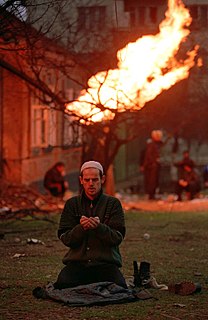 W
WAn ethnic conflict is a conflict between two or more contending ethnic groups. While the source of the conflict may be political, social, economic or religious, the individuals in conflict must expressly fight for their ethnic group's position within society. This final criterion differentiates ethnic conflict from other forms of struggle.
 W
WThe 2020 Inner Mongolia protests was a protest caused by a curriculum reform imposed on ethnic schools by China's Inner Mongolia Department of Education. The two-part reform replaces Mongolian with Standard Mandarin as the medium of instruction in three particular subjects and replace three regional textbooks, printed in Mongolian script, by the nationally-unified textbook series edited by the Ministry of Education, written in Standard Mandarin. On a broader scale, the opposition to the curriculum change reflects ethnic issues in China and the decline of regional language education in China.
 W
WThe 1984 anti-Sikh riots, also known as the 1984 Sikh Massacre, was a series of organised pogroms against Sikhs in India following the assassination of Indira Gandhi by her Sikh bodyguards. The ruling Indian National Congress had been in active complicity with the mob, as to the organisation of the riots. Government estimates project that about 2,800 Sikhs were killed in Delhi and 3,350 nationwide, whilst independent sources estimate the number of deaths at about 8,000–17,000.
 W
WThe Clash of Civilizations is a thesis that people's cultural and religious identities will be the primary source of conflict in the post–Cold War world. The American political scientist Samuel P. Huntington argued that future wars would be fought not between countries, but between cultures. It was proposed in a 1992 lecture at the American Enterprise Institute, which was then developed in a 1993 Foreign Affairs article titled "The Clash of Civilizations?", in response to his former student Francis Fukuyama's 1992 book, The End of History and the Last Man. Huntington later expanded his thesis in a 1996 book The Clash of Civilizations and the Remaking of World Order.
 W
WDirect Action Day, also known as the 1946 Calcutta Killings, was a day of nationwide communal riots by the Indian Muslim community announced by Muhammad Ali Jinnah. It led to large-scale violence between Muslims and Hindus in the city of Calcutta in the Bengal province of British India. The day also marked the start of what is known as The Week of the Long Knives.
 W
WEthnic cleansing is the systematic forced removal of ethnic, racial, and religious groups from a given area, with the intent of making a region ethnically homogeneous. Along with direct removal, such as extermination, deportation or population transfer, it also includes indirect methods aimed at forced migration by coercing the victim group to flee and preventing its return, such as murder, rape, and property destruction. It constitutes a crime against humanity and may also fall under the Genocide Convention, even as ethnic cleansing has no legal definition under international criminal law.
 W
WThe Navajo Livestock Reduction was imposed by the United States government upon the Navajo Nation in the 1930s, during the Great Depression. The reduction of herds was justified at the time by stating that grazing areas were becoming eroded and deteriorated due to too many animals.
 W
WThe Noakhali riots were a series of semi-organized massacres, mass rapes, abductions and forced conversions of Hindus to Islam and looting and arson of Hindu properties perpetrated by the Muslim community in the districts of Noakhali in the Chittagong Division of Bengal in October–November 1946, a year before India's independence from British rule.
 W
WPlan Verde was a clandestine military operation developed by the armed forces of Peru during the internal conflict in Peru; it involved the genocide of impoverished and indigenous Peruvians, the control or censorship of media in the nation and the establishment of a neoliberal economy controlled by a military junta in Peru. Initially drafted in October 1989 in preparations for a coup d'état to overthrow President Alan García, the operation was extended into the 1990 Peruvian general election and was reported to be subsequently executed under the government of newly elected president Alberto Fujimori following the 1992 Peruvian coup d'état. Shortly after the coup, Plan Verde was first leaked to the public by Peruvian magazine Oiga, with a small number of other media outlets also reporting access to the plan's documents.